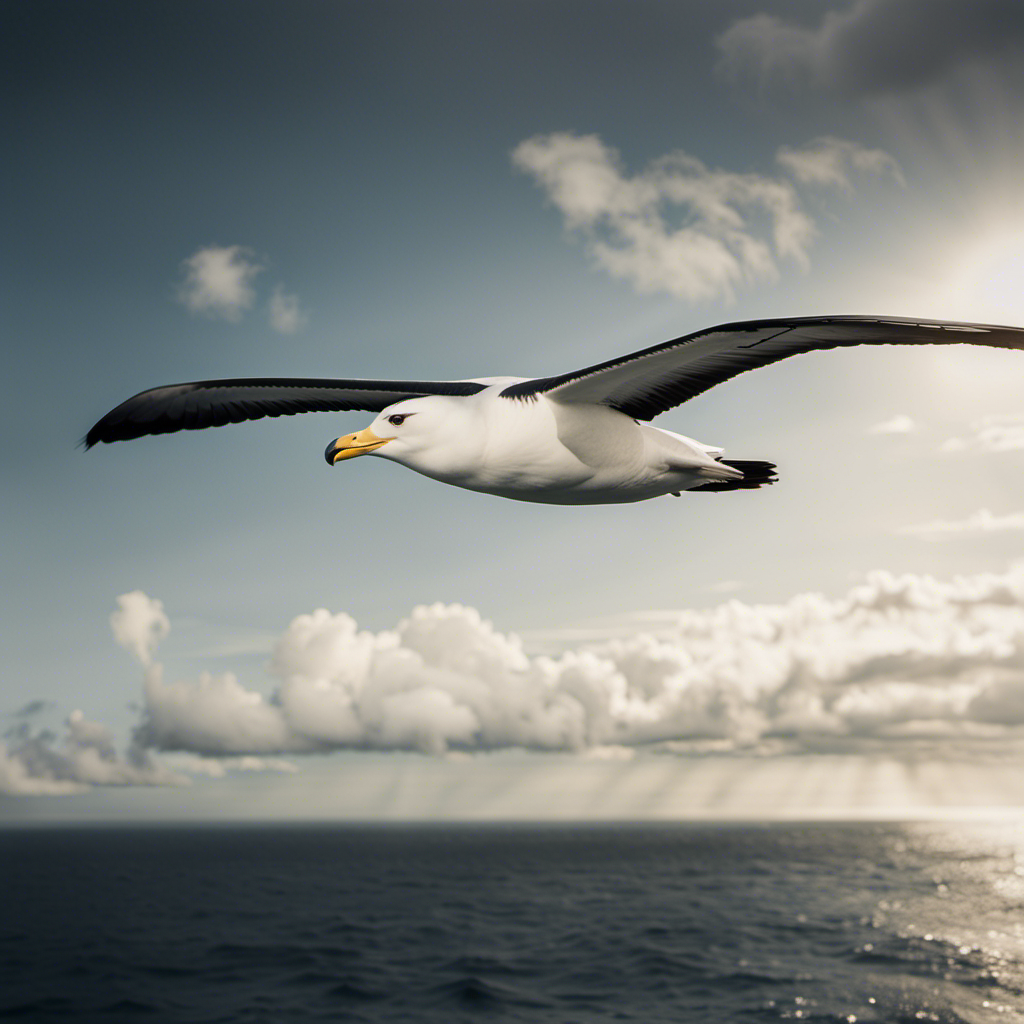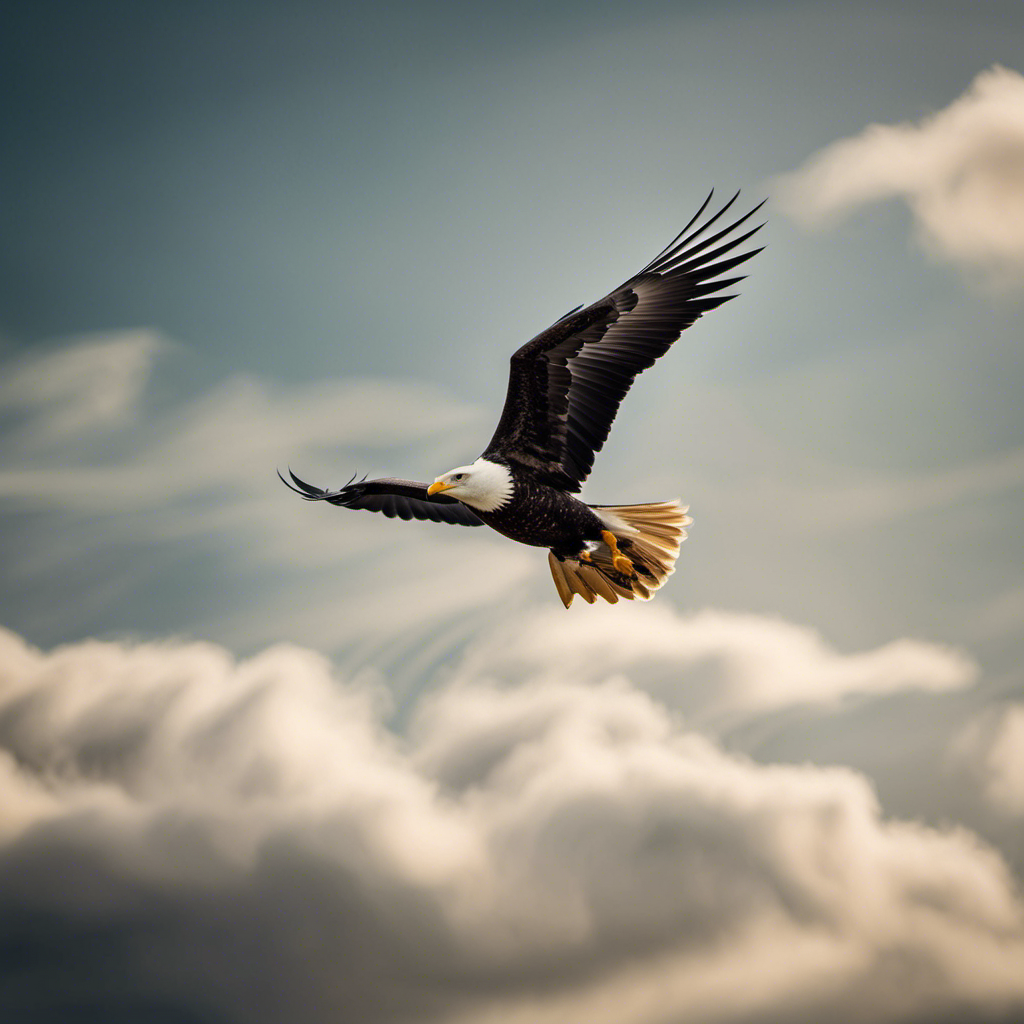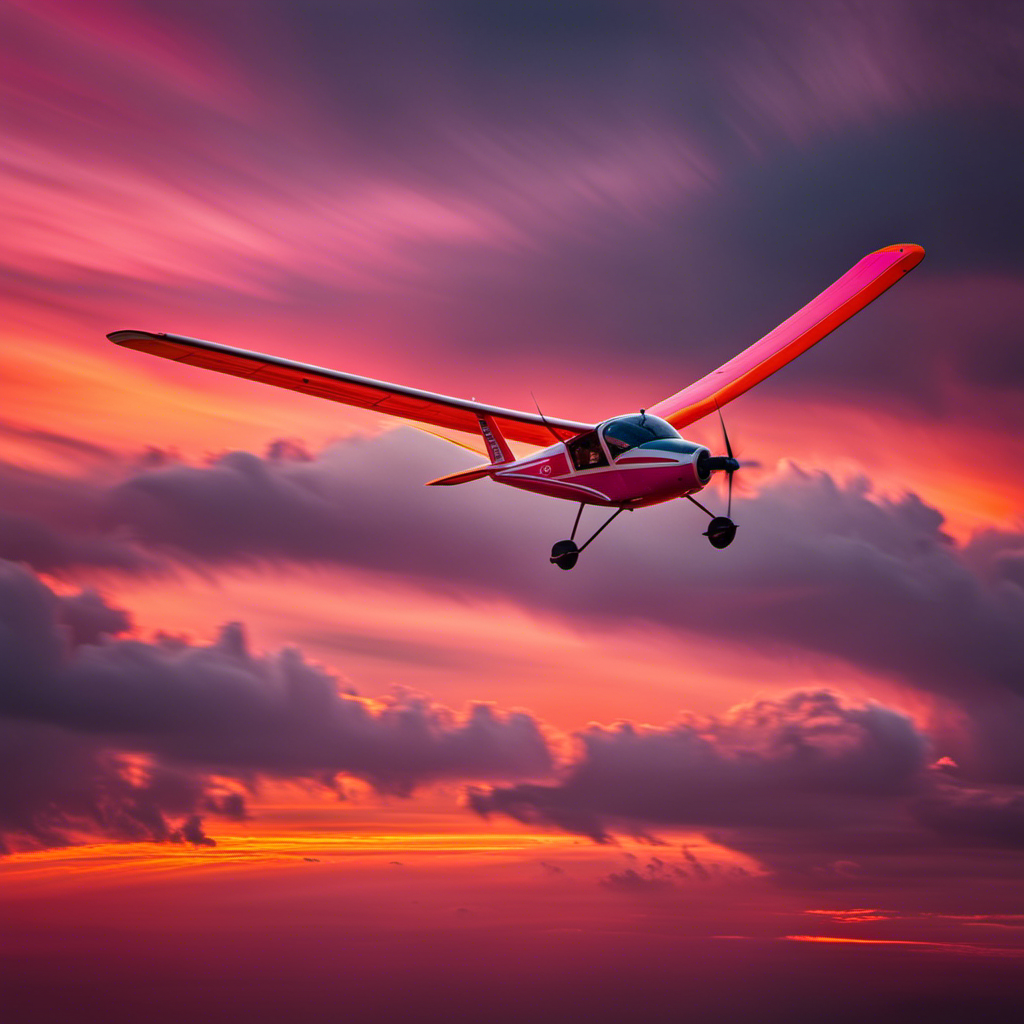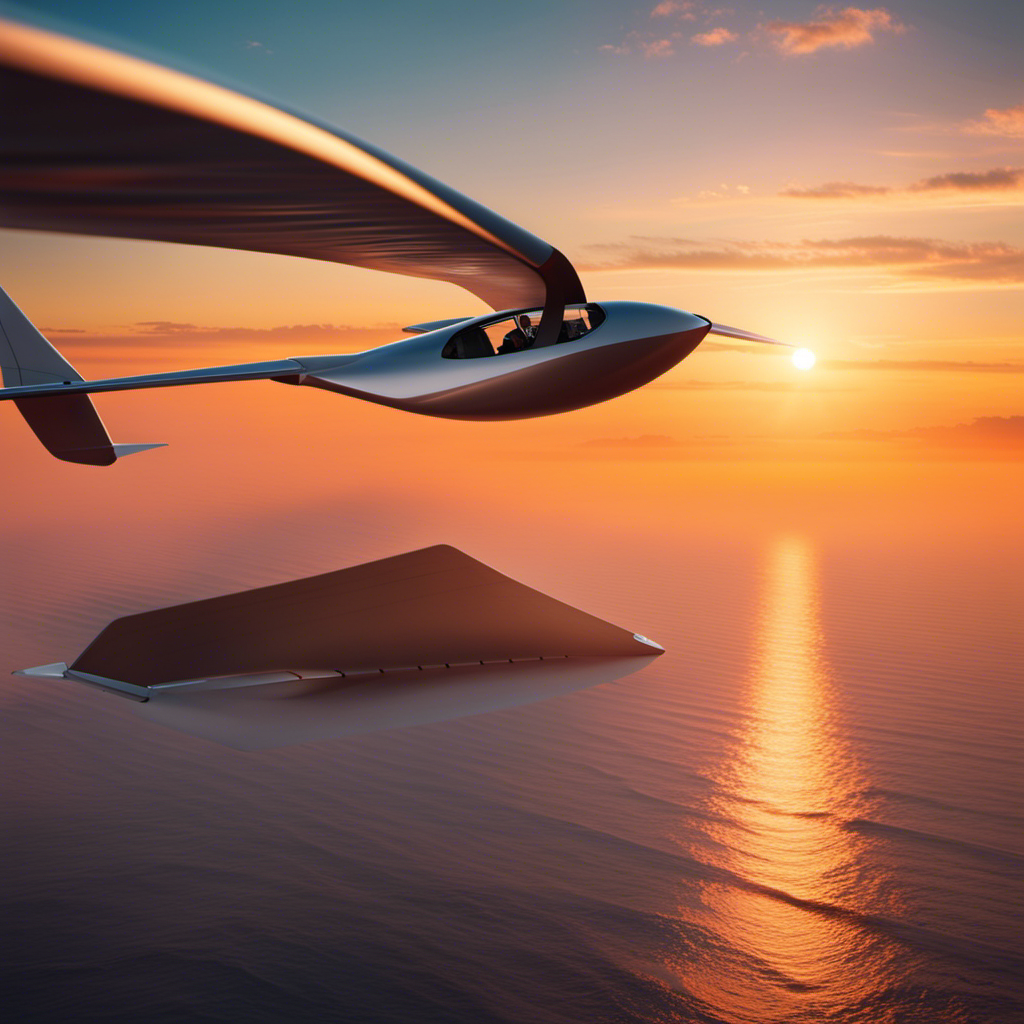Watching the magnificent albatross glide effortlessly through the air fills me with awe and curiosity. What allows this large bird to stay aloft for long periods without flapping its wings even once?
In this article, we will explore the fascinating anatomy and adaptations of the albatross that allow it to perform this remarkable feat. From its wing structure and design to the utilization of wind currents and updrafts, we will uncover the secrets behind the albatross’s incredible gliding abilities.
Key Takeaways
- Albatrosses use dynamic soaring and thermal soaring techniques to glide.
- Wind patterns and changes in air pressure play a crucial role in their gliding abilities.
- Environmental factors, such as wind gradients and oceanic features, attract albatrosses for gliding and foraging.
- Tracking technologies like GPS devices and satellite transmitters are essential for monitoring albatross movements and developing effective conservation strategies.
Albatross Anatomy and Adaptations
The albatross has a remarkable ability to glide effortlessly for long distances, thanks to its long wingspan and strong muscles. These adaptations allow it to navigate the skies with ease and efficiency.
The albatross is known for its unique flight patterns, which involve soaring and gliding rather than constant flapping of its wings. By utilizing wind currents and updrafts, the albatross can maintain its altitude and cover vast distances without expending much energy.
Wind navigation is a crucial skill for these birds, as it helps them find food sources and locate breeding grounds. This ability to harness the power of the wind is made possible by the albatross’s exceptional wing structure and design, which we will explore in the next section.
Wing Structure and Design
With their long, narrow wings and unique design, albatrosses effortlessly soar through the air. These magnificent birds have evolved specialized wing structures and designs that enable them to achieve incredible flights.
Here are the key features that contribute to their exceptional gliding abilities:
-
Wing Shape: Albatrosses have long, slender wings that are ideal for generating lift. The elongated shape allows for efficient airfoil formation and minimizes drag.
-
Wing Loading: Albatrosses have a low wing loading, which means their wings support relatively little weight. This allows them to stay aloft for extended periods without expending much energy.
-
Aspect Ratio: Their wings have a high aspect ratio, meaning they are long and narrow. This feature enhances lift generation and reduces induced drag, further improving their glide performance.
-
Flexibility: Albatross wings are highly flexible, allowing them to adjust their shape and angle of attack to optimize lift and maneuverability in varying wind conditions.
With their wing structure and design optimized for gliding, albatrosses are able to effortlessly navigate the skies.
In the following section, we will explore the fascinating aerodynamics of their glide.
Aerodynamics of Glide
To understand how these magnificent birds achieve such incredible flights, let’s delve into the fascinating aerodynamics of their glide.
Albatrosses are able to stay aloft for long periods of time by utilizing thermals and air pressure to their advantage. Thermals are parcels of warm air that rise due to temperature differences in the atmosphere. By soaring in these updrafts, albatrosses can gain altitude without exerting much energy.
They also make use of air pressure differentials to maintain their glide. The curved shape of their wings and their ability to adjust their flight path allow them to generate lift and exploit variations in air pressure. This enables them to navigate efficiently through the sky, effortlessly gliding for great distances.
Utilizing Wind Currents and Updrafts
By harnessing the power of wind currents and utilizing updrafts, you can effortlessly soar through the sky like an albatross. Understanding wind patterns and thermal dynamics is crucial for successful gliding.
Wind patterns are the result of complex interactions between atmospheric pressure systems and the rotation of the Earth. Albatrosses have evolved to take advantage of these patterns, using their keen sense of sight and the ability to adjust their wings to maximize lift.
Updrafts, or rising columns of air, are another key element in gliding. They are created by thermal dynamics, which occur when the Earth’s surface is heated unevenly. By locating and riding these updrafts, albatrosses can gain altitude and prolong their flights.
Now, let’s explore energy conservation techniques employed by these magnificent birds.
Energy Conservation Techniques
Albatrosses maximize their flight time by conserving energy through various techniques. These magnificent seabirds have evolved unique flight mechanics that allow them to soar effortlessly for long periods. To help you appreciate their remarkable abilities, here are some key aspects of albatross energy conservation:
-
Wing morphology: Albatrosses have long, narrow wings that generate lift and reduce drag, enabling efficient gliding.
-
Dynamic soaring: By utilizing wind gradients at different altitudes, albatrosses can gain energy from the wind without flapping their wings.
-
Soaring techniques: Albatrosses employ a range of soaring techniques, including ridge soaring, thermaling, and slope soaring, to maintain their flight with minimal energy expenditure.
-
Foraging behavior: Albatrosses have adapted their flight patterns to optimize their foraging success, often following ships or congregating in areas with high food availability.
Understanding these energy conservation techniques sheds light on the remarkable capabilities of albatross flight. Now, let’s delve into their fascinating long-distance migration patterns.
Long-Distance Migration Patterns
Understanding the factors that influence their long-distance migration patterns will give you insight into the incredible journey these birds undertake. Albatrosses are known for their extensive migration routes, spanning thousands of kilometers across oceans. These routes are not random, but rather a result of their foraging behavior.
Albatrosses rely on specific feeding areas, such as upwelling zones, where nutrient-rich waters attract their prey. They carefully select these areas, and their migration patterns are adapted to reach these prime foraging grounds. By understanding the availability of food resources and the navigation abilities of these birds, scientists can gain a better understanding of their migration patterns. This knowledge is crucial for conservation efforts and for predicting how albatross populations may respond to changes in their environment.
Transitioning to the subsequent section about albatross flight speeds, it is important to consider how these migration patterns influence their energy expenditure.
Albatross Flight Speeds
You can observe how albatross flight speeds vary depending on factors such as wind conditions and their foraging behavior.
Albatross flight mechanics play a crucial role in determining their speed. These magnificent birds have long, narrow wings, which enable them to glide effortlessly through the air. The shape of their wings allows for efficient lift and reduced drag, maximizing their flight performance.
Additionally, albatrosses are known for their ability to use dynamic soaring techniques, where they take advantage of wind currents to gain altitude and speed.
Their flight speed can also be influenced by their foraging behavior, as they may adjust their flight patterns to search for food.
With these factors in mind, it is fascinating to explore how albatrosses utilize their gliding techniques and strategies to traverse vast distances and navigate the open ocean.
Gliding Techniques and Strategies
Their ability to use dynamic soaring techniques allows albatrosses to effortlessly navigate the open ocean. Dynamic soaring is a specialized gliding technique used by these birds to harness the energy of wind gradients. By flying in a zigzag pattern, albatrosses take advantage of the difference in wind speed between the surface and higher altitudes. They gain speed by descending into the lower wind zone and then ascend back up, converting the potential energy into kinetic energy.
This unique method of flying allows albatrosses to cover vast distances with minimal effort. In addition to dynamic soaring, albatrosses also utilize thermal soaring, which involves using rising columns of warm air known as thermals to gain altitude. These thermals are usually found over land masses and can provide the birds with the necessary lift to maintain their flight.
Transitioning into the next section, the gliding abilities of albatrosses are influenced by various environmental factors.
Environmental Factors Affecting Gliding Abilities
Flying conditions can greatly impact how well albatrosses are able to navigate and glide in the open ocean. To understand the environmental factors that affect their gliding abilities, it is important to consider wind patterns and air pressure.
-
Wind patterns: Albatrosses rely on favorable wind patterns to soar effortlessly through the sky. They seek out areas with strong and consistent winds, such as the Roaring Forties in the Southern Hemisphere, where prevailing westerlies create ideal conditions for gliding.
-
Air pressure: Changes in air pressure can also influence albatrosses’ gliding abilities. They are able to detect subtle variations in air pressure, which helps them locate areas with updrafts or thermals. These upward air currents provide the necessary lift for sustained flight and allow albatrosses to cover vast distances without expending much energy.
-
Oceanic features: In addition to wind patterns and air pressure, albatrosses also take advantage of oceanic features, such as upwelling zones and frontal boundaries, which can concentrate prey items. These areas attract albatrosses, as they offer ample opportunities for foraging while gliding.
Understanding how these environmental factors affect albatrosses’ gliding abilities is crucial for their conservation and protection efforts. By preserving their habitats and ensuring the availability of suitable flying conditions, we can help these magnificent birds thrive in the open oceans.
Conservation and Protection Efforts for Albatross Species
Now that we understand the environmental factors influencing the gliding abilities of albatrosses, it is crucial to discuss the conservation and protection efforts for these magnificent seabirds.
Conservation initiatives play a vital role in safeguarding albatross populations and their habitats. To effectively protect these species, tracking technologies have become invaluable tools. By fitting albatrosses with GPS devices and satellite transmitters, researchers can monitor their movements and gather critical data on their foraging patterns, migration routes, and breeding grounds.
This information enables conservationists to identify high-risk areas and implement targeted measures to mitigate threats such as bycatch, overfishing, and habitat degradation. Additionally, these tracking technologies facilitate international collaboration, allowing researchers from different regions to work together to develop comprehensive conservation strategies.
Through these efforts, we can ensure the long-term survival of albatross species and preserve the delicate balance of our marine ecosystems.
Frequently Asked Questions
How do albatrosses find food during their long-distance migrations?
During their long-distance migrations, albatrosses find food by employing their feeding habits and following specific migration patterns. These patterns allow them to locate areas abundant in prey, ensuring their survival throughout their journey.
What is the average lifespan of an albatross?
The albatross, a majestic creature soaring through the skies, has an average lifespan of 50 to 60 years. These remarkable birds exhibit a unique breeding pattern, known as biennial breeding, where they reproduce every other year.
Do albatrosses build nests to lay their eggs?
Yes, albatrosses build nests on remote islands to lay their eggs. These nests are made of grass, twigs, and feathers. Conservation efforts are focused on protecting their nesting sites and reducing threats to their populations.
How do albatrosses navigate over vast oceanic distances?
Oh, the wonders of albatross navigation! These magnificent creatures rely on their impressive migration patterns and flight adaptations to traverse vast oceanic distances. Let’s dive into the scientific intricacies of their remarkable journey.
Are there any predators that pose a threat to albatrosses during their gliding flights?
During their gliding flights, albatrosses face predation risks from sharks and other large seabirds. To mitigate these threats, albatrosses have evolved flight adaptations such as their large size, long wingspan, and ability to fly at high altitudes.
Conclusion
In conclusion, the albatross showcases an awe-inspiring ability to glide effortlessly through the skies. Its remarkable anatomy and adaptations, such as its wings designed with precision and efficiency, allow it to harness wind currents and updrafts. This conservation of energy enables the albatross to traverse vast distances. The albatross’s mastery of gliding techniques and strategies is evident in its impressive flight speeds. However, we must remain mindful of the environmental factors that can impact these magnificent creatures’ gliding abilities. Therefore, conservation and protection efforts are crucial in ensuring the continued survival of albatross species. By doing so, we can allow them to grace our skies with their graceful glides for generations to come.









